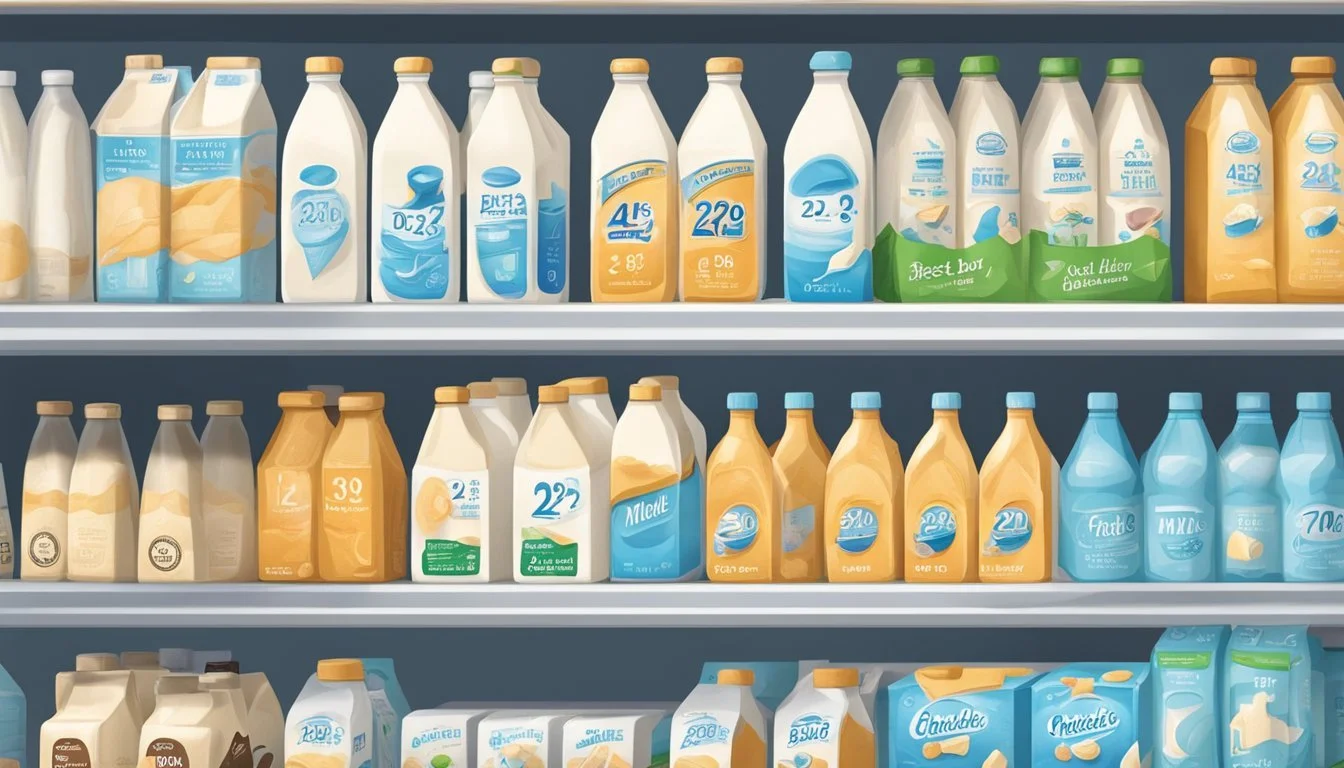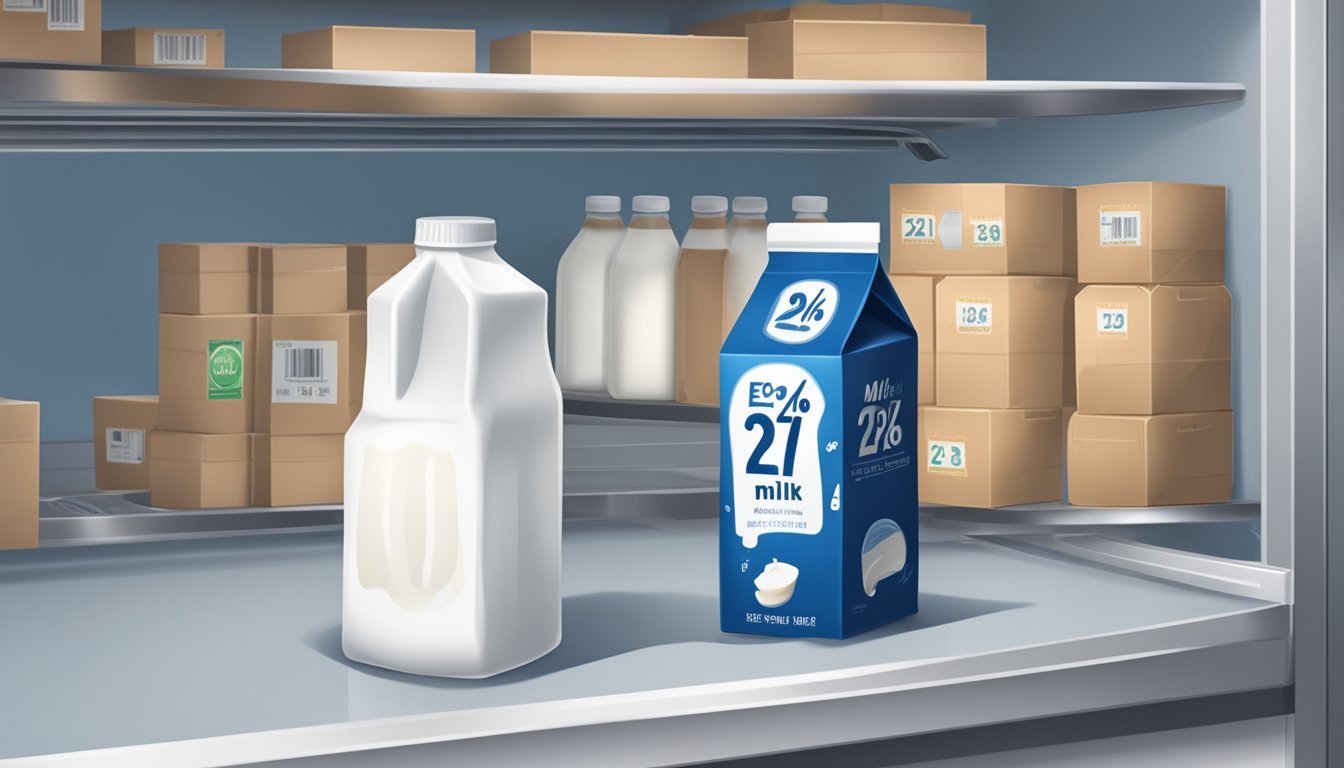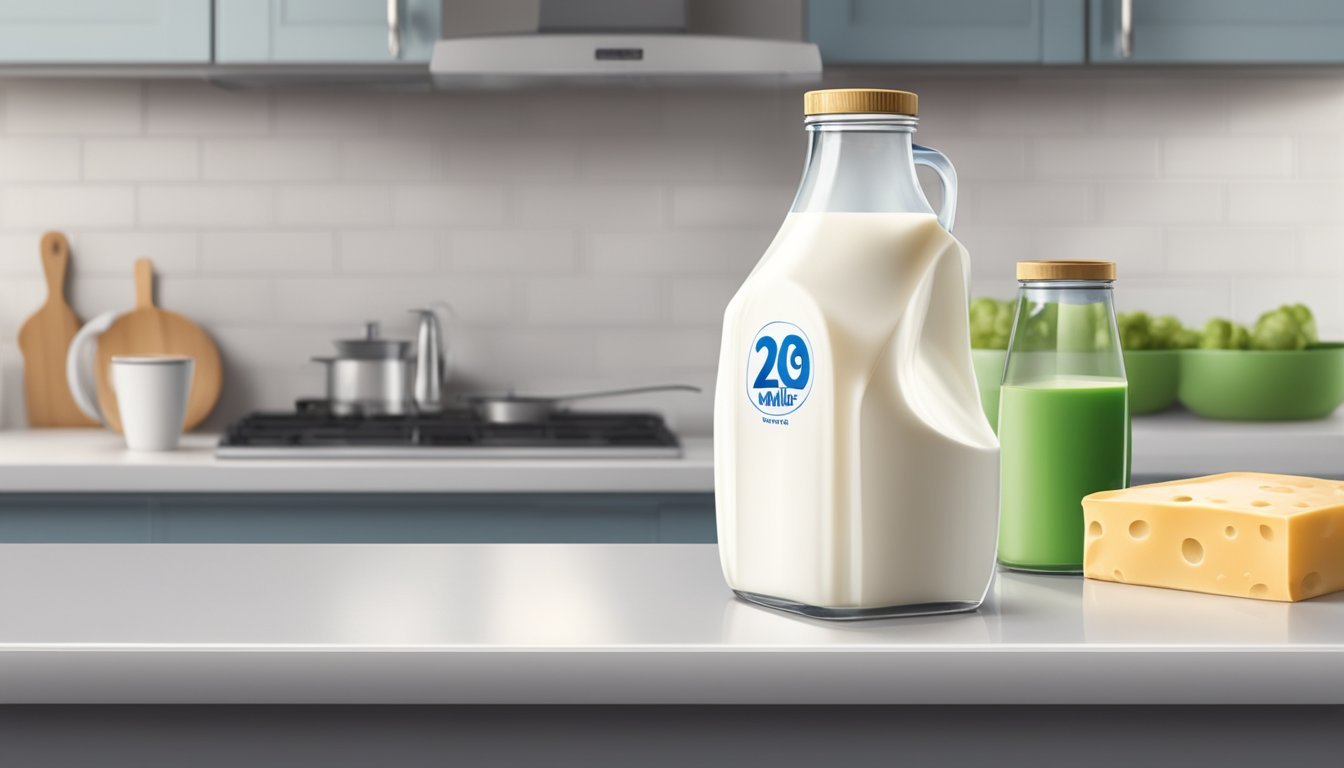How Long Does 2% Milk Last?
Understanding its Shelf Life
Determining the shelf life of 2% milk is a common concern for consumers looking to balance freshness with food safety. 2% milk, also known as reduced-fat milk, strikes a middle ground in the milk-fat spectrum, offering a lighter option compared to whole milk without entirely skimming the fat content. The shelf life of 2% milk, as with other types of milk, is influenced by factors such as processing methods, storage temperature, and the date printed on the carton.
Unopened 2% milk typically lasts 5-7 days past the printed sell-by or use-by date when kept refrigerated consistently. The precise duration can vary based on the initial quality of the milk and the conditions under which it is stored. Once 2% milk is opened, it is advisable to consume it within 7 days, although its freshness can be compromised if not stored properly.
To maximize the longevity of 2% milk, consumers should store it at or below 40 degrees Fahrenheit and keep it tightly sealed when not in use. Exposure to higher temperatures or frequent temperature fluctuations can accelerate the growth of bacteria, leading to milk spoilage. It is important to note that while the sell-by date is a useful guide, the actual freshness of the milk can be best determined by a sensory evaluation that includes smelling and visually inspecting the milk before consumption.
Understanding Milk Labels
Milk labels can often be a source of confusion, with various dates printed that indicate milk's freshness. It's important to understand the significance of each type of date labeling to ensure the milk is enjoyed while it is at its best quality.
Meaning of Sell-By Date
The sell-by date on a milk container is the date until which a retailer can display the product for sale. This date is not an indication of the product's safety to consume; rather, it guides stock rotation for stores. Milk is generally safe to drink for a short period beyond the sell-by date if it has been stored properly.
Differences Between Use-By, Best If Used By, and Expiration Dates
Use-By Date: This date is the last date recommended for the use of the product while at peak quality. It's the manufacturer's estimate of how long the milk will remain at its freshest. After this date, the quality of the milk may decline, but it may still be safe to consume.
Best If Used By Date: This date indicates when a product will be at its best flavor and quality. It is not a purchase or safety date, and consuming the milk past this date may mean a compromise in taste rather than safety.
Expiration Dates: Expiration dates are more definitive than the preceding labels, as they mark the end of the product's estimated shelf life. Beyond this date, the milk should not be consumed due to potential spoilage or food safety concerns.
Milk, including 2% milk, should be consumed by these dates, but if it has been kept continuously refrigerated, it may still be safe and wholesome for a short time after the printed date. It is essential to inspect the milk for signs of spoilage, such as off-smell or curdling before consumption.
Storing 2% Milk
Proper storage techniques are crucial for extending the shelf life of 2% milk and maintaining its freshness. The two key factors to focus on for optimal storage are maintaining the correct refrigerator temperature and choosing the right location within the refrigerator.
Optimal Refrigerator Temperature
For 2% milk to stay fresh as long as possible, it should be kept in a refrigerator that is set to the appropriate temperature. The ideal temperature range for a refrigerator is between 34°F and 40°F (1°C and 4°C). Temperatures higher than 40°F can accelerate the growth of bacteria, causing the milk to spoil prematurely.
Proper Storage in the Refrigerator
When placing 2% milk inside the refrigerator, it's important to select the proper location to ensure consistent cooling:
Avoid the refrigerator door: The temperature here fluctuates with frequent opening and closing.
Back of the fridge: The coldest part of the refrigerator, which is best for milk storage.
Middle or lower shelves: These areas are cooler as hot air rises.
By adhering to these practices, the shelf life of refrigerated 2% milk can be maximized. It is also essential to ensure the refrigerator is not overpacked to allow for proper air circulation around the milk.
Factors Affecting Milk Spoilage
Milk spoilage is a result of bacterial growth that leads to changes in milk's taste, smell, and composition. Understanding the role of pasteurization and the influence of temperature is key to maximizing milk's shelf life.
Bacterial Growth and Pasteurization
Milk spoilage occurs as bacterial growth proliferates, producing byproducts that adversely affect its quality. Although milk is pasteurized to kill harmful bacteria, some psychrotrophic bacteria—microorganisms that thrive at cooler temperatures—can still cause spoilage. The pasteurization process is vital as it significantly reduces the initial load of harmful bacteria and extends the milk's shelf life; however, it does not sterilize it, which allows for eventual spoilage.
Effects of Temperature on Spoilage
Temperature is crucial in determining the rate at which milk spoils. Keeping milk refrigerated at or below 40°F slows bacterial growth, thus delaying spoilage. Variances in storage temperature can hasten spoilage; for instance, milk left at room temperature will spoil much faster than milk that is kept chilled. Regularly maintaining low temperatures not only impedes bacterial growth but also preserves the milk's desirable qualities for longer periods.
Identifying Spoiled Milk
One can determine if 2% milk has spoiled by paying attention to changes in smell, taste, and texture, as well as visual signs. Spoiled milk poses a risk to quality and safety and should not be consumed.
Changes in Smell, Taste, and Texture
Smell: Fresh milk has a mild, pleasant aroma. Spoiled milk, on the other hand, often acquires a sour smell due to bacterial growth that produces lactic acid.
Taste: While one should not taste milk that smells bad, spoiled milk has a distinct sour taste contrary to the creamy flavor of fresh milk.
Texture: Spoiled milk may develop a thicker or clumpy consistency. The presence of lumps or a slimy texture indicates spoilage.
Visual Signs of Spoilage
Color: Fresh 2% milk has a consistent, white color. Any discoloration can indicate spoilage.
Quality: Milk of good quality should pour smoothly without any particles or residue. Visual evidence of mold or an uneven consistency points to spoiled milk.
Milk Consumption Safety
When it comes to consuming 2% milk, understanding the safety implications is crucial to avoid health risks. Spoiled milk can lead to foodborne illnesses, and recognizing the signs of spoilage is integral to food safety.
Risks of Consuming Spoiled Milk
One can identify spoiled milk by a sour smell, an off-taste, and a curdled texture. Consuming milk that has gone bad is risky, as it may contain harmful bacteria that can cause vomiting, diarrhea, and other foodborne illnesses. It is important to observe the milk’s expiration date and to smell and taste the milk before consumption. After the expiration date, even if not spoiled, milk begins to degrade in quality and may be less pleasant to consume.
Foodborne Illnesses Related to Milk
Milk can harbor dangerous bacteria such as Salmonella, Listeria, and E. coli, which are potential causes of food poisoning. The Food Safety and Inspection Service recommends that milk be stored at temperatures below 40°F (4°C) and consumed by the printed sell-by date to uphold food safety standards. Once opened, 2% milk should be consumed within a week, and individuals should remain vigilant about storage conditions to minimize the risk of foodborne illness. It is imperative to handle milk properly and ensure that it is pasteurized, as raw milk increases the risk of contamination.
Maximizing Milk Freshness
To retain milk’s best quality and extend its shelf life, consumers can adopt certain storage practices. These can significantly reduce food waste and help keep milk tasting fresh for as long as possible.
Tips to Extend Milk's Shelf Life
Placement in the Fridge: Store milk at the back of the refrigerator, where temperatures are coldest and most stable, and on a middle or bottom shelf rather than the door to avoid temperature fluctuations.
Temperature Settings: Keep the refrigerator temperature between 32°F and 39°F to slow spoilage.
Airtight Containers: Transfer milk to an airtight container if the original packaging is compromised.
Limited Exposure: Minimize the time milk is out of the fridge to decrease bacterial growth.
Freezing and Thawing Milk
Freeze By: For optimal freshness, freeze milk before the sell-by date.
Freezing Milk:
It's advisable to leave about an inch of space in the container, as milk will expand when frozen.
Pour milk into an airtight container or a freezer-safe bag to preserve taste and prevent odor absorption.
Thawing Milk: Thaw frozen milk in the refrigerator to maintain safety and quality. It may take a day or more to thaw completely, depending on the volume.
Texture Changes: Be aware that frozen and thawed milk can experience some texture changes due to fat separation, which are more noticeable in 2% milk than in whole milk. Shaking the milk well after thawing can help recombine the components.
Types of Milk and Their Shelf Lives
The shelf life of milk is influenced by its fat content, processing methods, and storage conditions. Understanding the differences between whole, 2%, and skim milk as well as pasteurized and raw options can guide consumers in making informed decisions about their purchases and storage practices.
Comparison Between Whole, 2%, and Skim Milk
Whole milk has approximately 3.25% milk fat and is often praised for its rich flavor. 2% milk, also known as reduced-fat milk, contains 2% milk fat, offering a balance between taste and reduced fat content. Skim milk, with less than 0.5% milk fat, is virtually fat-free.
Whole Milk: Shelf life of 5-7 days after the printed date when refrigerated.
2% Milk: Similar to whole milk, lasting approximately 5-7 days post-printed date.
Skim Milk: Can last slightly longer, around 7 days or a bit more, due to lower fat content.
Shelf Life of Pasteurized vs. Raw Milk
Pasteurized milk undergoes a heating process that kills harmful bacteria, extending its shelf life:
Pasteurized Whole Milk: Lasts 5-7 days after its "best by" date when refrigerated.
Pasteurized 2% Milk: Shares a similar shelf life to whole milk, about 5-7 days past the label date.
Pasteurized Skim Milk: Can last about 7-10 days after its printed date.
In contrast, raw milk, which is milk that hasn't been pasteurized, can spoil more quickly due to the presence of natural bacteria:
Raw Milk: Generally lasts 7-10 days when refrigerated, depending on the handling and initial bacterial load.
Nutritional Aspects of 2% Milk
2% milk, also known as reduced-fat milk, provides a balanced blend of essential nutrients while containing less fat than whole milk. One cup of 2% milk typically contains about 122 calories. Despite the reduced fat content, it still retains a significant amount of protein, offering about 12 grams per cup, which is crucial for muscle repair and growth.
The fat content in 2% milk is lower than that of whole milk, standing at approximately 5 grams per cup, with about 3 grams of that being saturated fat. Though reduced in fat, it provides essential vitamins and minerals necessary for maintaining good health. The calcium content is noteworthy, as it boasts around 285 milligrams per cup, contributing to bone health and strength.
In addition to calcium, 2% milk offers a good source of Vitamin A and some B vitamins, integral for vision and energy metabolism. Its contents also include essential nutrients like phosphorus, potassium, and sodium in varying amounts.
For those with lactose sensitivities, lactose-free versions of 2% milk are available which offer the same nutritional benefits without the lactose, making it a feasible alternative.
Nutrient Content in 2% Milk (per cup) Calories 122 Protein 12g Fat 5g (3g saturated fat) Calcium 285mg
It's also a versatile item in the kitchen, suitable for drinking straight, adding to cereal, or using in cooking and baking, providing nutritional benefits without the extra fat content of whole milk.
Impact of Milk Spoilage on Waste
Milk spoilage is a significant contributor to food waste, with economic and environmental repercussions that concern both consumers and the food industry.
Contributions to Food Waste
Milk is a perishable commodity, and the spoilage of 2% milk can lead to considerable amounts of food waste. According to the United States Department of Agriculture (USDA), dairy products account for a large portion of the overall food waste in the United States. When 2% milk spoils, it not only becomes inedible but also necessitates appropriate disposal to prevent health risks, which adds to the volume of wasted food.
Economic and Environmental Considerations
The premature spoilage of 2% milk presents economic challenges, both for households and the dairy industry at large. The cost of discarded milk due to spoilage can accumulate, impacting the average consumer's grocery budget.
From an environmental standpoint, milk spoilage aggravates the strain on waste management systems and contributes to greenhouse gas emissions during the decomposition process. The USDA recognizes the environmental burden instigated by food waste and underscores the need for improved food storage solutions to extend shelf-life, therefore mitigating the impact on both the economy and the ecosystem.






